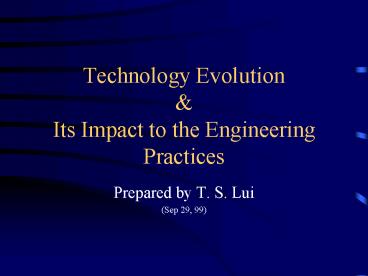Technology Evolution PowerPoint PPT Presentation
1 / 27
Title: Technology Evolution
1
Technology Evolution Its Impact to the
Engineering Practices
- Prepared by T. S. Lui
- (Sep 29, 99)
2
Abstract
- The aim is to expose the new skill-sets of
engineers today as a result of technology
advancement. As technology is evolving in rocket
speed, engineers have to absorb its impacts by
continually equipping themselves with new
knowledge, skills and approaches. Examples of
consumer electronics on technology evolution are
given to elaborate the points. The focus of new
skill-sets is put on collaboration,
specialisation and innovation.
3
Technology
- a. The application of science, especially to
industrial or commercial objectives. - b. The scientific method and material used to
achieve a commercial or industrial objective. - The American Heritage
4
Evolution
- A gradual process in which something changes into
a significantly different, especially more
complex or more sophisticated, form. - The American Heritage Dictionary of the English
Language
5
Situations
- Technology advancement is extremely fast
- Very short life cycle
- Super high integration
- High software / hardware complexity
- Difficult for an engineer to master a subject
even in a limit scope
6
(No Transcript)
7
Questions
- How day-to-day engineering practices have to be
adopted for the on-going changing situations? - Let's have some discussion.
8
Natural Selection
- The preservation of favorable variations and the
rejection of injurious variation. - The Origin of Species, Charles Darwin, 1859
- i.e. elimination of unfit.
9
Types of Works of an Electronic Design Engineer
- Past
- Digital
- Analog
- RF
- Software
- Now
- RF / Linear
- ASIC
- System Design
- Application Software
- Embedded Design
- Firmware
- DSP
- ATE
- Etc.
10
Technology EvolutionOur Experience
- Transistors to VLSI
- Discrete to system-on-chip
- Microprocessor 4 bits to 64 bits
- Analog / RF design to digital
- Simple firmware to Java JVM
- Simple OSD interface to 3D graphics
- Gadgets to systems
11
Engineering Practices in the PastTransistor to
VLSI
- Transistor
- Hand calculation
- Experiment on prototype circuits
- Refine design based on test results
- Some may use SPICE models
- From circuit design to PCB layout, testing could
be handled by 1 engineer
12
Engineering Practices in the PastDiscrete to
system-on-chip
- Discrete Circuits
- Standard libraries (Ex-stock)
- Commodities
- Standard application circuits
- Schematic capture
- Single/double side PCB
- Manual PCB layout design
- Textbook based
13
Engineering Practices in the PastASIC design in
early 80
- Technology -- 3 to 5u
- Apple computer mother board approx. 3k gates
- Schematic capture
- Simulator in main frame computer
- 0.18u
- Over million gates
- Mix signal design
- VHDL
- Workstation
14
Engineering Practices in the PastMicroprocessor
4 bits to 32 bits
- Microprocessor 4 to 8 bits
- Small program size
- Usually in assembly language
- Cross assemblers in Apple computer (early 80)
- Changes based on requirements
- Single engineer work
- Real-time control applications
- 32-bit
- Large program size
- C or C
- Speed from 10 MIPs to over 300 MIPs
15
Engineering Practices in the PastSimple firmware
to Java JVM
- Embedded software
- 512KB to over 16MB
- 3 to over 10 engineers
- C or C
- Modular design
- RTOS base
- Middleware for applications (e.g. Java)
- Simple firmware
- 2KB to 32KB in program size
- 1 to 2 engineers works
- Assembly language
- Usually programs not reused
16
Engineering Practices in the Past Simple OSD
interface to 3D graphics
- Simple OSD (on-screen display)
- Text based, black white on TV
- Limited display area
- Simple user guides
- Built-in in microcontrollers
- Small firmware
- No special tools for content development
- 2D-3D graphical accelerator
- Graphical based
- Multiple windows
- Fancy user interface
- Zoom in / out
- Graphical library
17
Engineering Practices in the Past Gadgets to
systems
- Gadgets
- Self contained. No system interaction usually
- Bound by few (international) standards
- Systems
- Interconnected
- Interactive
- Interoperability
- Complicate standards
18
Today Engineering PracticesIllustrated by
Examples
- ADSL Interactive Settop Box
- Hardware architecture
- Software architecture
- System architecture (network level)
19
Highlight of Features of the Interactive Set-top
Box (1)
- ADSL (DMT) ANSI T1.413 Issue 2 compliant
network interface - ADSL link (service provider connection) supports
AAL0/5 encapsulated ATM - Supports AAL/5 and AAL/0 PDU at line speed (25.6
Mb/s) at both directions - Supports at least 8 simultaneous virtual circuits
PVC or SVC in any combination - Bi-directional infrared compatible with IrDA (115
kb/s)
20
Highlight of Features of the Interactive Set-top
Box (2)
- MPEG 2 video decoder
- Compliant with ISO/IEC-11172 and ISO/IEC-13818-2
video - 2D and 3D graphics processing
- MPEG 2 audio decoder supporting MPEG 1and MPEG 2
(Dolby AC-3TM -optional) - ISO7816 compliant smartcard reader
- 10BaseT Ethernet communication interface
21
(No Transcript)
22
(No Transcript)
23
Requirement in Today's Engineering Practices (I)
- Very high design complexity
- System level -- Metropolitan network scale
- CAD, computer simulation approach
- Strong software dependence
- Engineering skills -- Specialization
- Modularized design
24
Requirement in Today's Engineering Practices (II)
- Design collaboration in team level, company
level, multi-company level. - Strong requirement in technology management
- Technology outsourcing
- Global collaboration
25
Threats Opportunities
- If the country were open on its borders, new
forms would certainly immigrate, and this also
would seriously disturb the relations of some of
the former inhabitants. Charles Darwin. - Borderless
- Distanceless
26
Home-grown or Outsource
- Home-grown technology
- Outsourcing
- US, Europe
- India
- China
27
Some Suggestions
- Work hard on foundation
- Build own core skills
- Focus
- Collaboration
- Outsourcing
- Technology management
- Innovation
- Keep up

